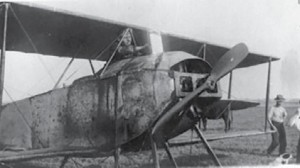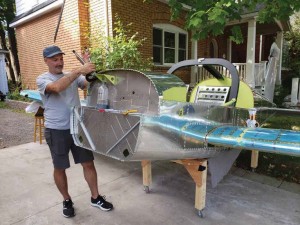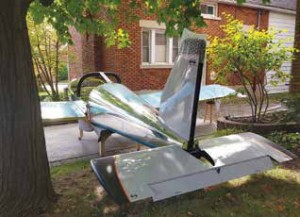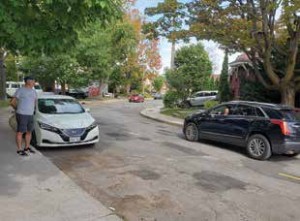Lorne Abugov
Old Ottawa East resident Maurizio Penna is building an airplane in his basement, garage and his kitchen!
According to Penna, he began the project “…about 15,000 rivets ago! It’s kind of like a giant IKEA product.”
Few people are aware that Old Ottawa East (OOE) ranks as one of Canada’s pioneering communities in aviation, able to boast the first intercity airplane flight in Canadian history when William C. Robinson landed his tiny plane in Slattery’s Field off Main Street in October 1913 after completing a flight from Montreal carrying mail and daily newspapers.

The bi-plane flown by William C. Robinson in October 1913 sits on the bumpy pastureland of Slattery’s Field in Old Ottawa East where the aviator landed his craft after the first inter-city flight in Canadian history. Photo from History of Ottawa East Archives
And, until recently, even fewer people in this community were aware that Maurizio Penna, a present-day OOE resident, was continuing the tradition of community airplane pioneers more than a century later, by building his own airplane inside his Mason Terrace home and garage.
But all that changed on Saturday, September 18th, on a sunny late morning and early afternoon, when Penna emerged from his home with a 60% completed full-sized, two-seater, do-it-yourself (DIY) all-aluminum Van’s RV12 aircraft. With little fanfare, Penna set about to an afternoon of work, attaching the wings that he built in his basement last winter to the fuselage that he built in his garage the year before.
“What the heck is that?” intoned this reporter and his wife as we drove west along Mason Terrace and caught a glimpse of a huge and shiny metal “thing” consuming most of Penna’s driveway and half of his front lawn, wedged between a tree and a garden plot.
“Good grief, it is an airplane!” we answered our own question, dumbstruck!
Over the next few hours, a steady parade of unsuspecting drivers and pedestrians in this quiet corner of Old Ottawa East were literally stopped in their tracks at the sight of the airplane, and of Penna working away with his wrenches and rivet gun, entirely non-plussed by the general fuss and commotion his DIY labour-of-love project seemed to be having on the curious locals.
“What are you doing?”, asked one motorist who stopped to gawk, blocking Mason Terrace to vehicular traffic for a good five minutes as she grilled the soft-spoken Penna on whether it was a real airplane, how he got it onto his driveway, and what his future intentions were.
“Is that an airplane?” asked one neighbourhood kid. “You got a permit for that thing?” questioned an elderly stroller. The questions were hitting Penna like a wave of air currents, yet he calmly and quietly responded to each, all the while attempting to get on with the work of affixing the aluminum wings to the snub-nosed, as-yet motorless craft that is both his current passion and his life-long dream.
“Well, I’ve always been interested in flying since I was a little kid, so I took it up recently in my 40s. And I’ve always liked the idea of building an airplane,” says Penna. “I’ve always built stuff, and I thought this would be a pretty neat project.”

Maurizio Penna, pictured here with his wrench in hand, took his indoor DIY project public in mid-September and had curious neighbours flocking to his Mason Terrace driveway to watch him build his airplane. Photo by Lorne Abugov
In response to a question about how exactly one builds an airplane in his garage, Penna explains that you just have to go on-line and google Van’s Aircraft Total Performance (https://www.vansaircraft.com/) and join Van’s Air Force of home builders. As the website says: “Anyone can do it!”
According to Penna, the aircraft is shipped to customers in stages from a factory in North Plains, Oregon – a small town about 25 miles west of Portland. “It arrives in five sections in huge wooden crates. My plan was to have one crate per year shipped to Ottawa, so that the build would take me five years. But…”, Penna grins, “I’m ahead of schedule!” He started building the plane three years ago and he expects to complete it next year and fly it in 2023.
He graciously took a few moments from his work and from answering questions from neighbours to respond to more questions from The Mainstreeter. On the plane itself, Penna was quick to quote impressive metrics. “So, when I finish it, it will fly at about 200 kilometers an hour for about four to five hours, at up to about 14,000 feet in altitude, for which I would need oxygen, but normally in a range of between 3,000 and 5,000 feet,” he explained.
As for the cost of his RV12 two seater, Penna initially hesitated: “Well, that depends on whether or not my wife is going to see this article.” A moment later, when told that she likely would, he nonetheless confessed that it would “range somewhere between $60,000 and $100,000 depending on the avionics and the options” that he selected from the company.

The tailgate portion of Maurizio Penna’s Van’s RV12 airplane is squeezed in between a tree and a garden patch of his Mason Terrace home. Photo by Lorne Abugov
Both he and his wife are licensed pilots and currently fly out of the Smiths Falls airport, from where his under construction plane will also fly. Asked if the craft was guaranteed to be safe and airworthy, Penna did not hesitate: “You need to register a new airplane, kind of like a building permit for a house. And there’s a series of inspections, so inspectors from Transport Canada would come here – and they already have – to inspect work at different stages. And when it’s completed, they’re going to come back and give it a certificate of airworthiness,” he notes. “And then at that point, I become the test pilot. And I’ll have to do the first flight. I’m limited for the first 25 hours of flight, to flying within 25 miles of the airport. And after that, I can fly anywhere I want.”
The next obvious question – “So, where do you want to fly to first?” Expecting maybe Montreal or Toronto, the not-so-obvious answer was: “Oshkosh, Wisconsin. When I started building this plane,” Penna recalls, “I put up this sign in my garage that says Oshkosh 2025”
Huh?
Oshkosh, it turns out, is the site of EAA AirVenture Oshkosh, the largest annual gathering of aviation enthusiasts in the United States and the #1 rated airshow in the world. Who knew?
According to the website, “the show has over 10,000 aircraft in attendance with a little bit of everything represented, including warbirds, homebuilt aircraft, ultralights and vintage planes.” Before the pandemic, the airshow attracted 500,000 spectators annually.
“It’s the biggest convention in the world for home built aircraft. So, I’m giving myself about a year for all the testing and then I’m going to fly it to Oshkosh, about 6,000 miles. Because there are literally tens of thousands of small aircraft flying there, logistically, I’ll have to stop at some place along the way, meet up with about 50 or so other Van’s Aircraft owners, and we’ll all fly together into Oshkosh without causing any aircraft control tower issues.”

One of many drivers and pedestrians who were stopped in their tracks on a Saturday afternoon in September when Penna attached the wings of his plane to the fuselage on his driveway. Photo by Lorne Abugov
Penna may have company on the flight to Oshkosh. It turns out that there are approximately 20 other Van’s Aircraft currently flying in and around Ottawa, and three or four others under construction. “I know of several,” Penna says. “There are more than 1,000 of this specific model flying in total. Mine is something like 1,023.”
And if you want to be a passenger in Penna’s plane, occupying that second seat next to the pilot, you’ll have to weigh in at less than 250 pounds. “The weight of the plane, two passengers included, is limited to 1400 pounds. Of that, the two passengers can’t total more than 450 pounds.” For his part, Penna says he tips the scale at 200 pounds.
A nervous flyer, I squirm slightly and vow to eat larger portions, since I currently qualify.






